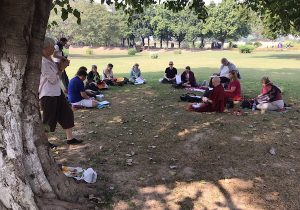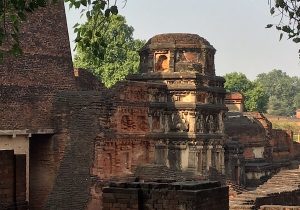Nalanda: once the pinnacle of knowledge and wisdom in the world
Nalanda is a place about 10 km from Rajgir. The Buddha used to come here quite often to meditate and teach. When you are at these places you can really feel that the atmosphere is conducive for those practices. It is calming and soothing just to sit and be.


It was King Asoka, about 300 years after the demise of the Buddha, who started building a stupa here refeering Shariputra. Shariputra was one of the most advanced desciples of the Buddha, he mastered all meditation states with ease and could tell about the mind and about consciousness. His teachings later culminated in the Abbhidharma. The stupa was later embellished and enlarged by following kings, it now lays partly in ruins.




In the beginning of our era the first buildings were erected to start a place of study and worship here. The story goes that with the digging of the fundaments a naga was wounded. A naga was a water spirit that could also life in the earth. They were very powerful. Because of this it was predicted by a sage that Nalanda would flourish for a thousand years, but then it would be totstroyed. And so it happened. It became the central Buddhist university of the world, housing 10000 students at the height of its history. A hundred three story monasteries housing 100 students (monks) each were constructed.


The famous students of this university revolutionized the Buddhist world and thinking. The most famaous is Nagarjuna. He developed the concept of emptiness to its ultimate level. Thereby laying the cornerstone for the development of Mahayana Buddhism. After him Asvagosha, Dharma Khirtti and many others developed Buddhist thought (a.o. The Yogacara school) and practice into what finaly became known as Vajrayana. Many people came from all over Asia to study here. One had to do an entrance exam to get in and many were refused. The libraries held enourmous amounts of texts in Sanscrit. But after 1000 AD the decline set in. In 1200 under the Moghul siege the University is said to have burned for three months. Now the black soot is still to be discerned on the remaining walls of the monasteries.
It just goes to show how impermanent our efforts are in this world. Now the main inhabitants of this place are no longer human.

